
 |
Points of Interest |
STRUGA-
POETRY AND BRIDGES ........................... |
| 1.
CHURCH OF ST. GEORGE Built in 1835 over a much older church from the 16th century, the small church of St. George stands in the centre of Struga. It contains frescos from the end of 19th century, but its real treasure is a small gallery of icons from 13th to 19th century, including the well known icon of St. George painted in 1267. A long inscription on the back of the icon mentions "Struga of Ohrid" ...........................  |
........................... 
|
|
2. THE NATURE MUSEUM |
||
........................... ................................ 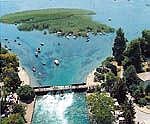 4. BLACK DRIM RIVER The Black Drim River flows out from Lake Ohrid near the "Drim" hotel and continues all the way to the Adriatic Sea. The banks of the river are an ideal place for romantic strolls. Each year, at the end of August you can listen to poets from all over the world reciting poetry in dozens of different languages. It is an inspiring occasion. |
||
3. VANGEL KODJOMAN GALLERY Vangel Kodjoman is one of the most prominent contemporary painters of Macedonia. Most of his work has been dedicated to his land and people. His paintings show scenes of old houses leaning over the narrow streets and a life that no longer exists. Some of his finest paintings are permanently exhibited in this gallery located in the middle of Struga. |
||
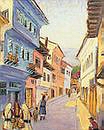 |
5.
CAVE CHURCH ARCHANGEL MICHAEL IN RADOZDA In a natural cave on a steep rock above the village of Radozda is a church dedicated to Archangel Michael. It is one of the oldest cave churches discovered on the shores of Lake Ohrid. Its frescos, painted on the uneven wall of the cave, date back to the end of 13th century. A close examination reveals the extraordinarily beautiful presentation of the Archangel Michael in the composition of the Miracle of Cana. Nearby is a fishermen's village with excellent restaurants. |
. 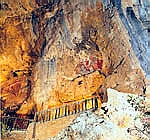 |
6.
CAVE CHURCHES IN KALISTA The small cave church of the Nativity of the Virgin, is situated high in the rocks on the western shore of Lake Ohrid near the village of Kalista and close to a monastery complex. Entry into the church is gained through a wall (which also provides the church's apse) into the natural space of the cave. The interor of the church was painted during the 15th or 16th century. Nearby, on a steep cliff overlooking Lake Ohrid is another cave church, dedicated to St. Athanasios. The natural opening of the cave has been used as a nave while the apse and the eastern wall are built of craggy stones. An old painting in the church is attributed to the second half of the 14th or the first half of the 15th century. |
||
7.
VISNI Located at the foot of the beautiful Jablanica Mountain about 10km northwest of Struga is the pretty village of Visni. It is surrounded by a forest of beech and oak trees. The cave church of the Holy Savior is a 3km walk from the village along a brook in a beautiful canyon. The fresco that decorates the wall and ceiling is dated from the end of the 14-th century. |
||||
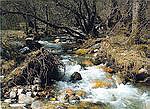 |
8.
EARLY CHRISTIAN BASILICA IN OKTISI Located near Vevcani in the mountain village of Oktisi is an ancient Christian basilica from the end of 5th or the beginning of 6th century. The mosaic floor of the church is richly decorated with representations of deer, horses, flowers, trees, and geometrical ornamentation. |
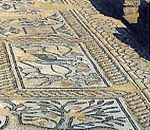 |
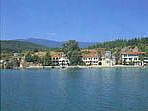 |
|
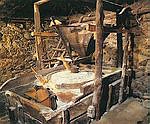 |
9.
VEVCANI Vevcani is a large village located 14 km northwest of Struga. It is built on a steep hillside and sheltered by a mountain. Its architecture is most appealing with many old houses and buildings of all styles and shapes. The sound of water can be heard running through channels throughout the village. It comes from the famous Vevcani Springs which have a water flow of between 400-4000 litres per second. Old water mills still grind corn, wheat and other grains as they have for centuries. Walk through the rich chestnut tree forest, climb up to the village of Gorna Belica or the glacial lakes. |
10. VAJTOS On the marked walking trails above Vevcani are the remains of the old Roman road, the Via Egnatia. It goes through a beautiful forest to Vajtos, an ancient stopping place and vantage point used by trade caravans traveling between the Adriatic coast and the Black Sea. The panoramic view over the whole Lake Ohrid valley is spectacular. 11. GORNA BELICA Located 1,600 meters above the tree line and close to the Albanian border, the village of Gorna Belica can be reached by driving, biking or walking from Struga, or by hiking from Vevcani. Nowadays, only two elderly ladies live all year round in the village, although other residents visit on weekends and holidays. The church of St. Petkai is undergoing restoration, but the two ladies are happy to tell its story and that of the saint. The owners of some of the holiday houses offer accommodation in their homes, and there is a modern hotel in the centre of the village. |
... |